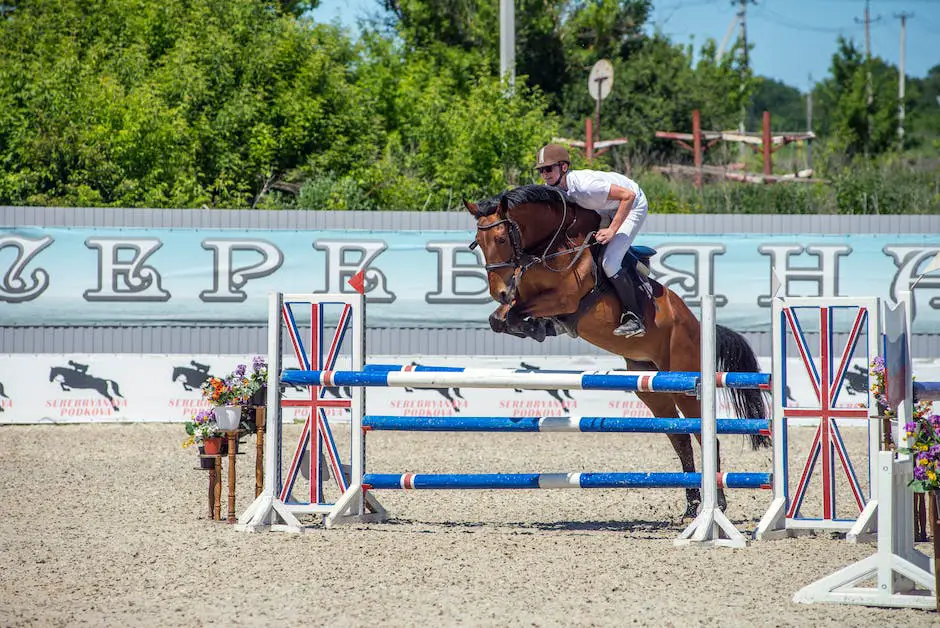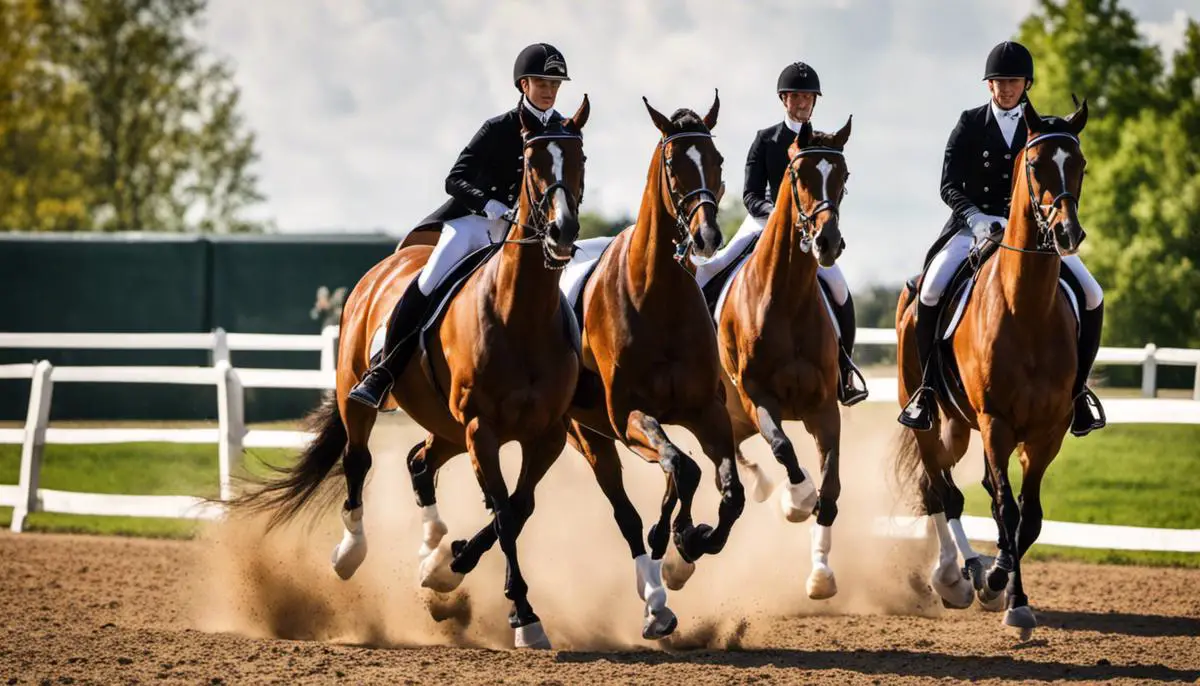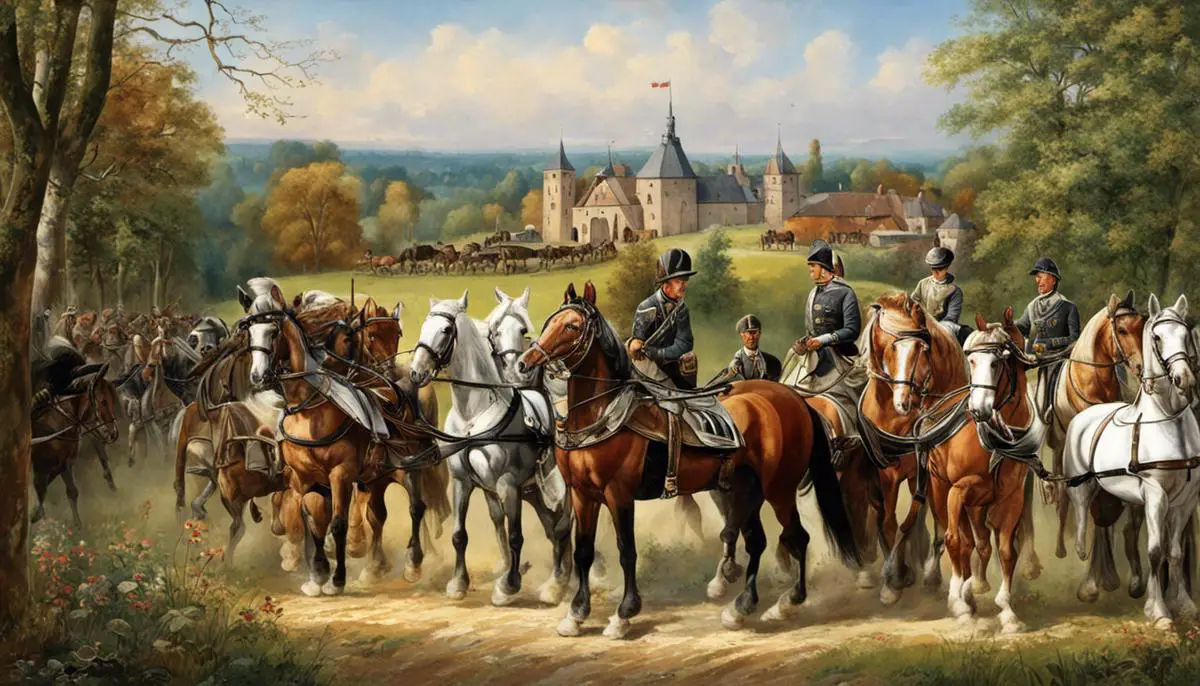Germany, a country known for its medieval castles, technological ingenuity, and world-class beers, also boasts a rich equestrian history that has left an indelible mark on the global horse industry. The beauty, elegance, and power of German horse breeds, like the noble Hanoverian, the strong Trakehner, and the graceful Oldenburg, have enchanted horse lovers worldwide. More than mere four-legged beasts, horses have been instrumental in shaping Germany’s history – serving as loyal war stallions, indispensable farm equipment, and champions in equestrian sports. This exploration dives deep into the history, the iconic breeds, famous individual horses, and the state of the modern horse industry in Germany, revealing the enduring love affair between Germany and its horses.
Table of Contents (Horspedia)
History of German Horses
Historical Significance of German Horses
German horses have played an essential role in multiple aspects of society throughout history, starting from ancient times until the present day. They have traditionally been used for transportation, agriculture, and warfare, but more recently have become famous in the arena of sports, especially dressage – a highly skilled form of riding performed in exhibition and competition that requires intense training and exceptional horse quality.
Key German Horse Breeds and Their Influence
One of the best-known German horse breeds is the Hanoverian. Originating from the former Kingdom of Hanover (now Lower Saxony) in the 18th century, these horses were initially used for farm work, but they due to their strength and agility, were soon found to be promising military and carriage horses. However, their worldwide fame has primarily grown from their outstanding abilities in show jumping and dressage.
The Holsteiner, another prominent German breed, hailing from the Schleswig-Holstein region, traces its origins back to the 13th century. They were push-pull horses used for agriculture, transportation, and in wartime. Now, they have an international reputation for their athleticism, intelligence, and versatility, marking them as superior show jumping and eventing horses.
Not to be forgotten is the Trakehner breed, noted for their endurance and versatility. Trakehners were instrumental in World War II as military horses, and their influence continues today in competitive equestrian sports.
Pivotal Moments in German Horse History
A significant turning point in German horse history came in the late 18th century with the official establishment of the State Stud of Celle, which marked the beginning of the Hanoverian breed. Similarly, the foundation of the Trakehner stud book in the early 20th century was a significant advancement for that particular breed. These institutions played a vital role in formulating systematic breeding programs, thereby enhancing the quality of German horses.
German Horses in Modern Times
In recent times, German horses have made a significant impact in sports, particularly dressage and jumping. German horse breeds dominate in the Olympics and world championships. The performance of these horses – a combination of strength, elegance, and agility – reflect the results of centuries of selective breeding.
Overview
German horses have long been celebrated across the globe due to their unparalleled combination of strength, versatility, and performance. These iconic horses not only hold legendary status within Germany, they have also significantly shaped the equestrian culture worldwide. This international recognition is a testimony to the superior breeding practices in Germany and the country’s steadfast commitment to maintaining and promoting equine excellence.

Famous German Horse Breeds
Spotlight: The Hanoverian Horse – A Beacons of German Breeding Tradition
The Hanoverian horse stands out as one of the most prestigious German horse breeds on a global scale. Originating from humble beginnings as sturdy carriage and farm horses in the 18th-century Kingdom of Hanover, these horses have since developed into formidable sport horses, recognized for their unwavering strength and agility. Hanoverians, typically sporting solid coat colors like chestnut, bay, black, gray, or occasionally white, are identified by their towering stature, averaging between 15.3 and 17.2 hands high, and their intelligent character.
Highly desired for Olympic disciplines such as dressage, eventing, and show jumping, Hanoverians are coveted for their firm muscular build, infusion of thoroughbred bloodlines, and intrinsic athletic prowess. With their dynamic, fluid movements and a palpable eagerness to perform, they’ve garnered numerous awards at international levels. The Hanoverians underscore the extraordinary results of German horse breeding, reflecting their capacity to adapt and perform across a wide range of equestrian disciplines.
Trakehner: The Eastern Royal Prancer
Trakehner horses were developed in East Prussia in the 17th century, where they were named after the town of Trakehnen. They are an elegant equine breed, often found in bay, black, chestnut, and occasionally, less conventional colors like roan and palomino. Trakehners are recognized and admired for their refined features, including a medium-sized head, expressive eyes, light yet robust build, and impressive height, usually between 15.2 to 17 hands high.
The breed is bolstered by its thoroughbred and Arabian heritage, creating a competitive, yet keen temperament which, when coupled with their superior stamina and agility, makes them proficient in eventing, jumping, and dressage. Trakehner horses have a global reputation for adaptability and talent, securing a high rank among warmblood breeds.
Oldenburg: The German Powerhouse
Originated in the Grand Duchy of Oldenburg in the 17th century, Oldenburg horses are renowned for their impressive size and formidable power. These horses showcase solid colors, predominantly black, brown, gray, or bay, and they are normally large-bodied with a strong neck and muscular build, averaging around 16 to 17.2 hands high.
Primarily bred for carriage and agricultural work, the Oldenburg has adapted through selective breeding to excel in dressage and show jumping. The breed’s powerful gait and height give them excellent scope in jumping and beautiful extensions in dressage. The upshot is an Oldenburg horse breed that embodies power and refinement, setting an international standard for top-quality warmblood horses.
In summary, German horse breeds, such as the Hanoverian, Trakehner, and Oldenburg, are globally praised for their remarkable versatility, excellence, and impressive athleticism. The exceptional characteristics, formidable size, and outstanding performance of these breeds have greatly shaped global horse breeding and equestrian sports. Hence, these breeds, with their superior quality and widespread impact, truly earn their status in equine circles.

Iconic German Horses
Spotlight on Donauwind: The First Grand Prix Dressage Horse
When speaking of illustrious German horses, one cannot overlook Donauwind, a well-known Trakehner stallion. Born in 1965, this magnificent stallion made history as the first ever Grand Prix dressage horse, thus setting exceptional standards for future contenders. Under the guidance of acclaimed equestrian Karin Schlüter, they secured individual silver and team gold at the 1971 European Championships. While Donauwind’s athletic achievements are remarkable, his contributions to horse breeding are equally significant. He was a highly coveted sire, with his offspring including numerous successful dressage and jumping horses.
Halla, the Triple Olympic Gold Medalist
Another remarkable German horse is Halla, a mare who achieved a feat unparalleled in the equestrian world. She is the only horse ever to have won three Olympic gold medals in show jumping: individual and team gold in 1956, and another individual gold in 1960. Uniquely, she achieved her 1956 individual gold when her rider, Hans Günter Winkler, was injured and she completed most of the course on her own with minimal guidance. Notably, Halla was also one of the first mares to be cloned in 2003, further cementing her legacy in the equestrian world.
Cor De La Bryère, the Influential Show Jumping Stallion
Cor De La Bryère was a Holsteiner stallion who had an indelible impact on German horse breeding practices. Foaled in 1968, he did not have an exceptional sports career himself, but is widely recognized as a pillar of modern show jumping breeding. His offspring include dozens of top-level show jumpers and successful stallions. Moreover, his progeny have been instrumental in the spread of Holsteiner bloodlines throughout the equestrian world, which is considered a desirable trait in jumping horses due to the breed’s strength, agility, and intelligence.
Totilas: The Dressage Phenomenon
Totilas, a Dutch Warmblood stallion, is among the most famous dressage horses worldwide. He was born in 2000 in the Netherlands, but rose to fame under the German rider Matthias Alexander Rath. Totilas is especially renowned for his world record-breaking scores in Grand Prix dressage, and he won three gold medals at the 2010 World Equestrian Games in Kentucky. His extravagant, expressive movement and his ability to perform complex dressage moves with apparent ease captivated audiences around the world. Despite controversy—some believed his training was harsh and unfair—and health issues in his later life, Totilas remains a symbol of dressage excellence.
Almé Z: The Progenitor of Renowned Show Jumping Champions
Known more for his distinctive lineage than his individual accomplishments, Almé Z, a striking French-bred, German-owned Zangersheide stud, remains a prominent figure in the sport of show jumping. With a blossoming career that began in 1966, Almé Z triumphed modestly in show jumping events throughout his life. However, his true prowess lay in his fantastic ability to sire world-class athletes, including the illustrious Ratina Z and Galoubet A. Almé Z’s legacy continues to echo throughout the show jumping world, lauded as a legendary sire, his monumental impact remains discernible in the pedigree of the current collection of champions.

Current German Horse Industry
Renowned German Horse Industry: Pinnacle of Breeding Excellence
The acclaim for Germany’s horse industry is universal, considering its scrupulous horse breeding regimens and unmatched expertise. Housing some of the world’s leading sport horses, especially in throwaway events such as dressage and show jumping, Germany’s attention to detail in tracking the lineage of their horses for generations is truly remarkable.
Hanoverians and Holsteiners are at the forefront of the German horse industry, embodying the most preeminent German breeds. The Hanoverian breed, celebrated for its mental agility, physical strength, and diverse skills, has been recognized globally for its contributions to international dressage and show jumping tournaments. Similarly, Holsteiners, with their impressive power, long-lasting stamina, and extraordinary jumping prowess, are widely cherished as superior athletes, setting high standards in the horse industry.
Modern Training and Competition Practices
In Germany, horse training and competition norms focus heavily on slow, careful, and meticulous training. The tradition of “Pferdeverstand,” which translates as “understanding the horse,” underpins this approach. The aim of training is not just to create a performing horse but to cultivate a partnership between the horse and rider.
In terms of competition, Germany holds numerous events throughout the year, including the CHIO Aachen, considered the world’s leading equestrian event. The competition attracts world-class German horses, providing a platform to display their strength, agility, and training. Germany’s success in global equestrian events, including the Olympics, demonstrates the effectiveness of its training and competition practices.
Economic Impact of German Horse Industry
The horse industry plays a vital economic role in Germany. The sector, inclusive of breeding, training, equestrian events, and horse-riding tourism, is valued at several billion euros. It provides direct and indirect employment to a significant number of people across various facets — from horse-breeding farms, training schools, vets, to tourism operators.
Furthermore, the export of German horses, especially sport horses, represents a critical revenue stream. German horse breeds, particularly Hanoverians and Holsteiners, command premium prices in international markets, which further bolsters the country’s economy.
A Cultural Staple: The Horse in German Society
The horse also retains a significant cultural role in German society. Horse riding is seen not just as a sport, but as an essential aspect of rural life. Many view it as intertwined with Germany’s historical and contemporary cultural identity.
In many regions, traditional festivities and parades often feature horses, underlining their cultural presence. For instance, in Bavaria, Leonhardi Ritt processions take place annually, inviting horse riders across the regions to ride together in a traditional festivity.
Overall, the horse remains firmly embedded in Germany’s cultural fabric, in urban equine sports, countryside living, and regional traditions. The combination of a strong economy, world-leading training and competition practices, and a deep-seated cultural appreciation for horses ensures that the German horse industry continues to flourish and maintain its global reputation for excellence.

As the chronicles of German horses conclude, one cannot help but admire their incredible journey. From their historical role in transportation and warfare to becoming globally renowned sports and entertainment icons, these exquisite creatures have shown resilience, adaptability, and unmatched strength. The magnificent breeds that Germany introduced to the world, like the Hanoverian, the Trakehner, and the Oldenburg, each infused with its unique traits and intrinsic worth, continue to thrive in the international equestrian landscape. Today, the German horse industry remains a hub of excellence and innovation, as the bond between humans and horses extends into the realms of culture, economy, and sport. Therefore, the legacy of German horses is not just a narrative of the past, but a continually unfolding saga that promises more illustrious chapters in times to come.
